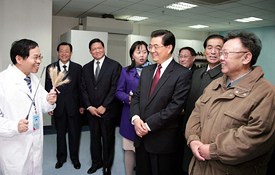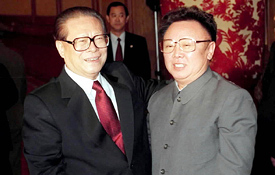 |
 |
|
SHARED DEVELOPMENT: Chinese President Hu Jintao and North Korean leader Kim Jong Il visit the Chinese Academy of Agriculture Sciences in Beijing in January 2006 (XINHUA) |
FRIENDLY TIES: Chinese President Jiang Zemin meets visiting North Korean leader Kim Jong Il in Beijing in January 2001 (JU PENG) |
The relationship between North Korea and South Korea eased up in the early 1990s. They signed the Agreement on Reconciliation, Non-Aggression, and Cooperation and Exchange in Seoul in 1991, and the Joint Declaration on the Denuclearization of the Korean Peninsula in 1992. The tendency was not accepted by Washington, which experienced a bad time in East Asia then.
The United States was forced to pull out from a military base in the Philippines, and felt the pressure of regionalism and pacifism in Japan and South Korea. Therefore, it couldn't tolerate the possibility of letting the South and the North jointly arrange the Korean Peninsula's future. And the nuclear issue of North Korea became the best leverage for Washington to dominate events on the peninsula.
Fights between Pyongyang and Washington got fiercer and fiercer on the nuclear issue, making the problem more complicated. In 2005, the six-party talks aimed at resolving the problem ended with a joint statement on September 19, in which the parties—North Korea, South Korea, the United States, China, Russia and Japan—agreed to settle the problem through peaceful solutions.
But North Korea conducted its first nuclear test several months later, claiming it was responding to then U.S. President George W. Bush's policy and U.S. attempts to smother North Korea. Pyongyang's action created negative consequences: U.S. propaganda of demonizing North Korea on the nuclear issue became more pronounced and conservative forces in South Korea came into power.
Deterioration of Pyongyang-Seoul relations led to a series of events. Pyongyang announced that it successfully conducted a second underground nuclear test in May 2009. In March 2010, South Korea's Cheonan warship exploded and sank, killing 46. South Korea claimed North Korea had attacked the warship and responded by launching an economic blockade against North Korea and staging large-scale military exercises. In November 2010, South Korean troops performed artillery drills near the Northern Limit Line, a disputed maritime border between South Korea and North Korea. After its protests fell on deaf ears, North Korea overreacted and opened fire at the nearby Yeonpyeong Island, killing two South Korean civilians. The external environment for North Korea's economic development worsened.
Fortunately, Pyongyang started to show a positive attitude toward resuming the six-party talks this year. According to the previous schedule, Pyongyang and Washington were going to have their third meeting on December 22. It was reported that North Korea expressed an active stance on accepting preliminary denuclearization measures, and it even might get into consensus with Washington on accepting investigations by the International Atomic Energy Agency.
The meeting had to be postponed because of Kim Jong Il's death. But it is expected that the U.S.-North Korean talks will head to a bright future, because both sides face a common historical opportunity—if they cannot seize it, they will lose it forever.
The author is an associate research fellow with the China Institute of International Studies
Key Facts About Kim Jong Il
Kim Jong Il was born on February 16, 1942. In 1960, he began to study at the Politics and Economics Department of Kim Il Sung University and graduated four years later.
He started working for the Central Committee of the Workers' Party of Korea (WPK) in 1964. On October 8, 1997, he was elected general secretary of the WPK Central Committee.
In April 1992, he was given the title of Marshal of the Democratic People's Republic of Korea.
He died on December 17, 2011.
(Source: Xinhua News Agency) | 